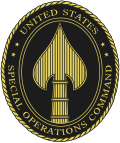| 1st Marine Raider Battalion | |
|---|---|
 1st Marine Raider Battalion insignia | |
| Active | October 26, 2006 - present |
| Branch | |
| Type | Special operations forces |
| Part of | Marine Raider Regiment |
| Garrison/HQ | Camp Pendleton, California |
| Commanders | |
| Commanding Officer (June 2019) | LtCol Theodore A. Bucierka [1] |
The 1st Marine Raider Battalion (1st MRB) is a special operations forces of the United States Marine Corps and a subordinate combat component of the Marine Corps Special Operations Command. The Battalions' organization was finalized in 2006 and is one of three battalions of the Marine Raider Regiment.

